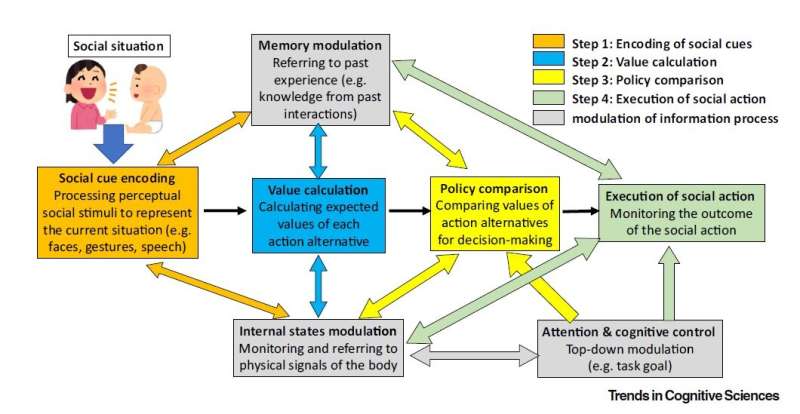A new cognitive study has proposed an action value calculator model to explain how infants modulate their social behaviors based on the social context. Credit: Mitsuhiko Ishikawa, Doshisha University, Japan
Society and social interaction play a key role in life for humans. The well-being of a person greatly depends upon their ability to be part of complex sociocultural institutions. Even during infancy, humans rely on their social interactions with other humans for social and cultural learning, subsequent adaptation to different social environments, and ultimately, survival.
Several studies have shown that infants do not respond automatically or reflexively to external cues, but instead adaptively modulate their social behaviors to suit their social context. Gaze-following is one such behavior that infants modulate based on their surroundings. However, a few studies have shown that infants' gaze-following can occur independently of their social context.
Consequently, the empirical evidence explaining contextual modulation of infants' social behavior is inconsistent. Therefore, there is a need for a theoretical framework that can effectively describe the mechanism underlying such behavioral modulations. To this end, a new study by Dr. Mitsuhiko Ishikawa—a JSPS Research Fellow at Doshisha University's Center for Baby Science—uses contextual modulation of gaze-following behavior as a model system to evaluate how infants contextually modulate their communicative behavior. The study was made available online on January 5 and published in Trends in Cognitive Sciences in March 2023.
"We proposed that, from infancy, humans integrate perceptual information, memories and current physiological state to determine the optimal behavior in any social context through a value-driven decision-making process," explains Dr. Ishikawa. This means that infants choose between different actions under every social context by assessing which action will result in the most rewarding outcome, such as acquiring new information or a social incentive.
Dr. Ishikawa, along with Prof. Atsushi Senju from the Research Center for Child Mental Development, Hamamatsu University School of Medicine, also proposed that external cues do not directly determine infants' social behavior. To support these hypotheses, both researchers built upon their existing empirical research to design the "action value calculator model," which describes the cognitive processes involved in how infants decide to behave during different social interactions.
This model suggests that infants first encode social cues in each context. These can include any kind of social stimuli, including faces, gestures, and speech. Then the infants process these social stimuli to form a representation of the current social situation. Thereafter, their brains calculate and compare the values of different alternative actions within a particular social situation. Once these action values are compared, infants finally choose to perform the optimal action that has the highest action value, that is, one that will result in the most suitable response/outcome in that social situation.
The entire process of action value calculation and comparison can also be influenced by memory of past experiences and internal states, such as physical or psychological signals of the body. Moreover, these action values can be updated based on the feedback received upon performing that action. Since social situations are often dynamic and can include interactions, this process becomes iterative. Thus, once an action is performed, the social context is updated and processed from the start in order to perform another action.
But how do infants learn how to assign values to their actions based on their social situation? According to the researchers infants are predisposed since birth to engage with social stimuli. Then, with experience, they learn the likely combinations of actions and their outcomes to determine which actions work optimally under which social context. Additionally, individual differences in social experiences, such as familial environment, can further shape how infants assign action values. For example, deaf infants raised by deaf parents exhibit more gaze-following behavior than hearing infants raised by hearing parents.
Essentially, this value-based model highlights the significance of the internal value calculation and decision-making process in infants and supports studies that suggest that infants contextually modulate their social behaviors instead of following external cues.
Envisioning how this research can be expanded further, Dr. Ishikawa says, "Our cognitive model could inspire empirical research of infants' social behavior, including social actions other than gaze-following, from the perspective of value-based decision-making. This could also be linked to mechanisms that shape individual and cultural differences in social behavior, and perhaps improve our understanding of the fundamental question of how humans interact socially in their daily lives."
More information: Mitsuhiko Ishikawa et al, Action value calculations in social context from infancy, Trends in Cognitive Sciences (2023). DOI: 10.1016/j.tics.2022.12.005
Journal information: Trends in Cognitive Sciences
Provided by Doshisha University























